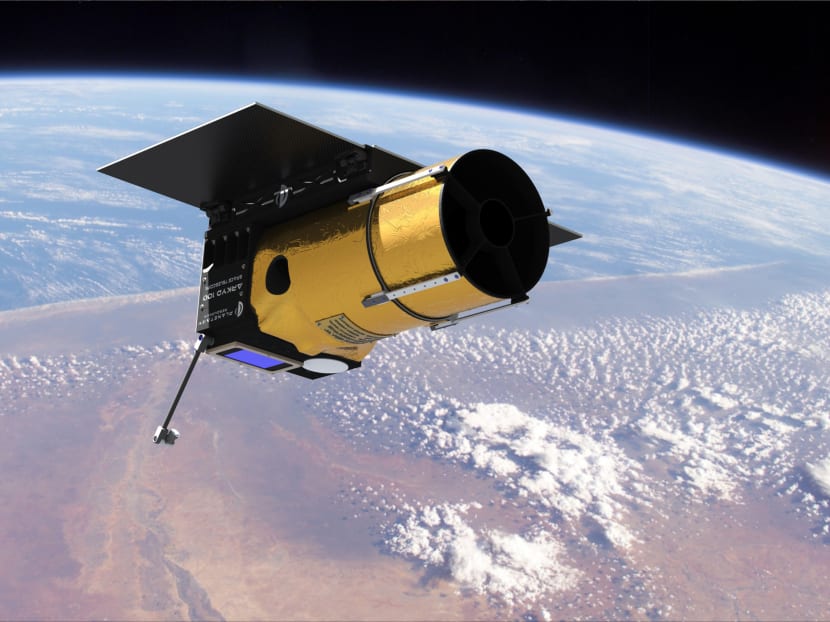Mining in space could cost less than a gas plant
MELBOURNE — Getting a mine up and running on the moon or an asteroid would cost less than building the biggest gas terminals on Earth, according to research presented to a forum of company executives and NASA scientists.

Computer rendering of Planetary Resources Inc.'s prospector spacecraft in low earth orbit. Source: Planetary Resources via Bloomberg
MELBOURNE — Getting a mine up and running on the moon or an asteroid would cost less than building the biggest gas terminals on Earth, according to research presented to a forum of company executives and NASA scientists.
A mission to Ceres, a dwarf planet 257 million miles from the Sun and the size of Texas, may cost about US$27 billion (S$38 billion). The expense includes 10 rocket launches to convey equipment, the extraction of metals and water, and the construction of an in-orbit facility to process the raw materials.
The costing comes from graduate business students at Australia’s University of New South Wales, which is also collaborating with the National Aeronautics and Space Administration on the economics of space mining. By comparison, Australia’s biggest single resources development — Chevron’s Gorgon liquefied natural gas plant — has an expected price tag of about US$54 billion.
Still, getting investors to buy into the grand vision that mankind has a future in the stars is a high bar to clear.
“We shouldn’t drink the Kool-Aid too hard,” said Mr Rene Fradet, deputy director of the engineering and science directorate at NASA’s Jet Propulsion Laboratory in Pasadena, California, and a speaker at the Off-Earth Mining Forum in Sydney yesterday (Nov 5). “Investors are out there, but they need to know what the risk and return will be,” he said by phone.
EVENTUAL COLONIZATION
Crucially, proponents no longer intend to deliver metals to Earth to replenish finite resources. The costs of a two-way journey are considered uneconomic and the focus instead is on providing materials for industries operating in space to power the exploration and eventual colonization of Mars and beyond.
Mining on the moon would be a relative snip with capital expenditure of about $9 billion, according to the research. Capturing parts of near-Earth asteroids, the target of companies already developing programs to begin mining in space, may be just US$492 million.
Advocates insist space mining will eventually develop into a trillion-dollar-industry supplying metals and water for habitats and fuels for rockets in a market led initially by space exploration programs and satellite operators.
SPACE ECONOMY
“Even if you found gold out there, I’d leave it out there,” said Mr Julian Malnic, a board member of Moffett Field, California-based Deep Space Industries, which plans to mine asteroids and conduct processing and manufacturing in space. “There’s a real economy out there to be built, and the materials are out there to build it from.”
Proof that the technology to mine in space is feasible is being established by programs including NASA’s Asteroid Redirect Mission, said Mr Fradet. The key step is building a credible business case that can convince skeptics in the mining industry, he said.
“It’s not a profit-making venture yet,” said Mr Jeff Coulton, a senior lecturer at UNSW’s School of Accounting, whose students made the space mining calculations and who also spoke at the forum being hosted by the university. “It may well be a profit making venture 20-to-30-to-50 years into the future,” he said.
GOOGLE BILLIONAIRES
Other costings are even lower. Each mission to mine an asteroid may cost only between about US$50 million and US$100 million, according to Planetary Resources, an asteroid-mining venture backed by Google billionaires Larry Page and Eric Schmidt.
Planetary Resources has held talks on its plans with chief executive officers and exploration heads of mining firms, President and Chief Engineer Chris Lewicki said by phone, declining to name the companies. The approach from miners is “how can we engage on this, so we’re not caught behind the times as it develops,” he said.
Top executives aren’t dismissive. Rio Tinto Group’s CEO Sam Walsh said in February that space mining poses interesting questions and if it can be developed, his company will be there. BLOOMBERG





